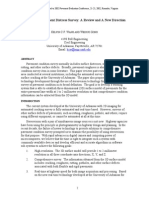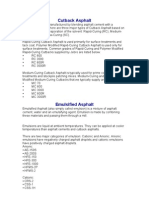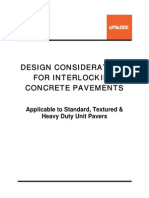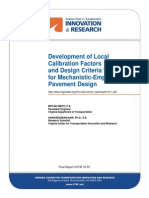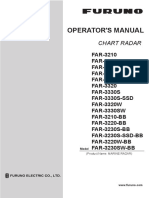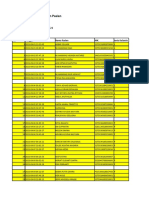Catalogue of Defects
Catalogue of Defects
Uploaded by
Choo Fu-KiatCopyright:
Available Formats
Catalogue of Defects
Catalogue of Defects
Uploaded by
Choo Fu-KiatOriginal Title
Copyright
Available Formats
Share this document
Did you find this document useful?
Is this content inappropriate?
Copyright:
Available Formats
Catalogue of Defects
Catalogue of Defects
Uploaded by
Choo Fu-KiatCopyright:
Available Formats
Catalogue of
Defects
Longitudinal
Crack
Transverse
Crack
Description
The direction of
crack is parallel to
the flow of traffic.
Causes
Fatigue pavement, unstable base and poor
construction.
The asphalt
Temperature drop significantly, shrinkage of the
perpendicular to the
hot mix asphalt (HMA) surface due to low
pavements
temperature of asphalt binder hardening,
centerline.
reflective crack caused by cracks beneath the
surface of HMA layer
Interconnecting or
interlaced cracking
Asphalt pavement distress instigated by sub-base
in the asphalt layer.
Crocodile Crack
failure, poor drainage and repeated
The cell size can
overloading.
vary in size up to
300 mm.
Examples
Block Crack
Interconnected
Hot mix asphalt shrinkage and temperature
crack that divided
cycling are the major cause of the block
the pavement into
cracking. The asphalt binder was unable to
rectangular piece.
expand can contract due to asphalt binder
The block range
aging and poor choice of asphalt binder in the
size can range from
mix of design.
0.1 m2 to 9m2 .
Raveling
The progressive
Loss of bonding between aggregate particles and
disintegration of the
the asphalt binder as a result of coating on
hot mix asphalt
dusty aggregate, aggregate segregation,
layer (HMA) as a
inadequate compaction during construction
result of
and mechanical dislodging by certain types of
dislodgement of
traffic.
aggregate particles.
Delamination
Respected roads
was loss large
discrete area of the
wearing coarse
layer, usually this
failure is
conjunction with a
clear delineation of
the wearing coarse
from the layer
below.
Inadequate cleaning during constructing the road
Inadequate tack coat before placing upper layer
Seepage of water through asphalt resulting in the
breaking of the bind between surface and layer
below
Adhesion of surface binder to the tires of
vehicles
Potholes
Patch
The presence of the water in the underlying soil
structure and the presence of traffic passing
Hole break of road
over the affected area. When the water was
pavement. Pothole
introduced into the underlying soil structure it
usually accompany
will weaken the supporting soil. After this area
with crocodile
has been affected traffic flow will break the
crack.
poorly supported asphalt surface. Continued
traffic action will ejects both asphalt and the
underlying soil material to create a hole in the
pavement.
A portion of new
hot mix asphalt
overlay an old
Treating the local distress on the pavement.
pavement. Normally
During the treating process the cold mix
this is due to
asphalt was introduce to repair the distress on
treating distress in
the pavement.
localized area
You might also like
- Nissan Navara Workshop ManualDocument12 pagesNissan Navara Workshop Manualbdsisira78% (9)
- HQ27 - Gurugram - Snapshot - Aug 2022Document16 pagesHQ27 - Gurugram - Snapshot - Aug 2022Manoj KumarNo ratings yet
- Pavement Deterioration and Its CausesDocument7 pagesPavement Deterioration and Its Causesخيرالله موسى نوافNo ratings yet
- Jitender TCS ReportDocument20 pagesJitender TCS ReportRishibhogal11No ratings yet
- FAR 145 Inspection SystemDocument44 pagesFAR 145 Inspection SystemFauzie Ahmad100% (1)
- 3 Otta SealDocument6 pages3 Otta SealPriti PaudelNo ratings yet
- Design and Construction Procedure of Otta Seal LatestDocument44 pagesDesign and Construction Procedure of Otta Seal LatestSujit DhitalNo ratings yet
- Unit-IV Pavement Management System 2023Document68 pagesUnit-IV Pavement Management System 2023Harsh patelNo ratings yet
- Automated Pavement Distress SurveyDocument17 pagesAutomated Pavement Distress SurveyDevela AvinashNo ratings yet
- 04 LVSR Wshop Kenya Feb06 OttaSeal ChOverbyDocument38 pages04 LVSR Wshop Kenya Feb06 OttaSeal ChOverbyAbdoAbdelNo ratings yet
- A Research Paper On Porous Asphalt PavementDocument6 pagesA Research Paper On Porous Asphalt PavementEditor IJTSRDNo ratings yet
- 6sec.600 (Concrete Pavement)Document35 pages6sec.600 (Concrete Pavement)aalignup arc & const. pvt ltdNo ratings yet
- Sabita Mabual 27Document68 pagesSabita Mabual 27Carel De JagerNo ratings yet
- Otta Seal PDFDocument2 pagesOtta Seal PDFLuis PilaresNo ratings yet
- SMA Mixture Design Requirements: Alexander W. (Sandy) Brown, P.EngDocument27 pagesSMA Mixture Design Requirements: Alexander W. (Sandy) Brown, P.EngYago Mendoza100% (1)
- Improving Road Durability Using Modified Asphalt in Malaysia: How Its Works?Document8 pagesImproving Road Durability Using Modified Asphalt in Malaysia: How Its Works?zeidan111No ratings yet
- Introduction To MEPDG Software: Mechanistic-Empirical Design Guide SoftwareDocument7 pagesIntroduction To MEPDG Software: Mechanistic-Empirical Design Guide SoftwareArmin MotahariNo ratings yet
- Check List For DPR Preparation of Rural Roads in Hilly AreasDocument4 pagesCheck List For DPR Preparation of Rural Roads in Hilly AreasRamesh Subba LimbooNo ratings yet
- 1.) Bitmix, Core PresentationDocument41 pages1.) Bitmix, Core PresentationBrian PaulNo ratings yet
- Manual Otta Seal PDFDocument70 pagesManual Otta Seal PDFWambugu MaInaNo ratings yet
- Man8 PDFDocument72 pagesMan8 PDFCarel De JagerNo ratings yet
- Application of Perpetual Asphalt Pavment Principles-LandeDocument16 pagesApplication of Perpetual Asphalt Pavment Principles-LandeElba BrizuelaNo ratings yet
- Asphalt CrackingDocument11 pagesAsphalt Crackingnajmuzuha027No ratings yet
- Millau Viaduct ConstructionDocument14 pagesMillau Viaduct ConstructionVishal RameshNo ratings yet
- Cold Mix Patch Work Method StatementDocument2 pagesCold Mix Patch Work Method StatementBhanu SudheerNo ratings yet
- Asphalt StabilizationDocument14 pagesAsphalt StabilizationJooke180No ratings yet
- Structural Design of Interlocking Concrete Paving Block: E. Palanikumar Pothuganti Uday KumarDocument4 pagesStructural Design of Interlocking Concrete Paving Block: E. Palanikumar Pothuganti Uday Kumarivanhendriprasetyo 127No ratings yet
- Flexible Pavement: Topic 631 - Types of Flexible Pavements & MaterialsDocument19 pagesFlexible Pavement: Topic 631 - Types of Flexible Pavements & MaterialsMaejann Cuartero100% (1)
- Theyse (1996) - Overview of South African M-E Design MethodDocument13 pagesTheyse (1996) - Overview of South African M-E Design MethodRodrigo DíazNo ratings yet
- Open Letter To Hon. Narendra Modi On Gross Wastage of Public Funds On Bituminous Resurfacing of Rural RoadsDocument6 pagesOpen Letter To Hon. Narendra Modi On Gross Wastage of Public Funds On Bituminous Resurfacing of Rural RoadsProf. Prithvi Singh KandhalNo ratings yet
- Cutback Asphalt ClassificationsDocument2 pagesCutback Asphalt ClassificationsJassy YEANo ratings yet
- Performance of Recycled Asphalt Pavement As Coarse Aggregate in ConcreteDocument12 pagesPerformance of Recycled Asphalt Pavement As Coarse Aggregate in ConcreteBrayan Stiven VIVIESCA GIRALDO100% (1)
- Catalogo Inglese Iterchimica 2019 PDFDocument38 pagesCatalogo Inglese Iterchimica 2019 PDFBesim QelajNo ratings yet
- Stabilization of Soil Sub-Base by Using Port Land CementDocument39 pagesStabilization of Soil Sub-Base by Using Port Land CementAnwar Hossain PolasNo ratings yet
- Worktips 10 Asphalt Paving With Automated Level ControlDocument2 pagesWorktips 10 Asphalt Paving With Automated Level ControlVany LunaNo ratings yet
- M 323 - Superpave Volumetric Mix DesignDocument18 pagesM 323 - Superpave Volumetric Mix DesignidelgardyNo ratings yet
- Highway Materials PDFDocument28 pagesHighway Materials PDFswarlu67% (3)
- Distress ID ManualDocument30 pagesDistress ID Manualramdasse100% (2)
- LS-805 - Rev 34 - May 2020Document6 pagesLS-805 - Rev 34 - May 2020ming_zhu10No ratings yet
- Seal Design and Construction (Additional Notes)Document43 pagesSeal Design and Construction (Additional Notes)Thabiso MotalingoaneNo ratings yet
- DMRB hd3816 Concrete Surfacing and MaterialsDocument27 pagesDMRB hd3816 Concrete Surfacing and MaterialsLebo.emx Mathosa100% (1)
- Volume 2 - RoadwaysDocument379 pagesVolume 2 - RoadwaysMohamed DarwishNo ratings yet
- Argus Americas AsphaltDocument10 pagesArgus Americas AsphaltRvrch FVNo ratings yet
- SMA-Guide Engl - 2006Document35 pagesSMA-Guide Engl - 2006Ale Chuno100% (1)
- Pavement Design 2013 ProjectDocument58 pagesPavement Design 2013 ProjectEr Mukesh PawarNo ratings yet
- Unilock Design ConsiderationsDocument31 pagesUnilock Design Considerationsd_ko_alam2169No ratings yet
- Recetas Cup Cakes AvionesDocument112 pagesRecetas Cup Cakes AvionesRubsoneproNo ratings yet
- CLVTDocument2 pagesCLVTOkello Steven100% (1)
- Subsurface DrainageDocument3 pagesSubsurface DrainageJohan Vd Merwe SnrNo ratings yet
- Evaluation of Stone Mastic Asphalt Mix by The Bailey Method DesignDocument8 pagesEvaluation of Stone Mastic Asphalt Mix by The Bailey Method DesignLin ChouNo ratings yet
- ATT 1379096439822 BitumenDocument41 pagesATT 1379096439822 BitumenIZIMBANo ratings yet
- Transpotation - Emulsions For Highway ConstructionDocument20 pagesTranspotation - Emulsions For Highway ConstructionAtish KumarNo ratings yet
- Foamed Asphalt MixDocument32 pagesFoamed Asphalt Mixentree4527No ratings yet
- Reclaimed Asphalt Pavement RapDocument10 pagesReclaimed Asphalt Pavement RapkomalNo ratings yet
- Chapter 3 PDFDocument17 pagesChapter 3 PDF123No ratings yet
- Performance Evaluation of Stone Matrix Asphalt Using Indonesian Natural Rock Asphalt As StabilizerDocument6 pagesPerformance Evaluation of Stone Matrix Asphalt Using Indonesian Natural Rock Asphalt As StabilizerAhmad FauziNo ratings yet
- History of PavementDocument8 pagesHistory of PavementPradip SarkerNo ratings yet
- Whole-Life Cost Analysis of Concrete Block Paving PDFDocument9 pagesWhole-Life Cost Analysis of Concrete Block Paving PDFSi ZhangNo ratings yet
- Evaluation of Resilient Characteristics of Stone Matrix Asphalt (Sma)Document4 pagesEvaluation of Resilient Characteristics of Stone Matrix Asphalt (Sma)Nikhil Gupta100% (1)
- Pavement Design Manual - 2002 Chapter Erreur ! Style Non Défini. Volume II - Rigid PavementsDocument24 pagesPavement Design Manual - 2002 Chapter Erreur ! Style Non Défini. Volume II - Rigid PavementsMoibon Heda100% (1)
- Nilex Tensar GlasGrid Pavement Reinforcement Product Selection GuideDocument4 pagesNilex Tensar GlasGrid Pavement Reinforcement Product Selection GuideSpiros LicoudisNo ratings yet
- Calibration Factors MEPDGDocument47 pagesCalibration Factors MEPDGRicardo Flores100% (1)
- Distresses in IndiqDocument64 pagesDistresses in IndiqAslam AliNo ratings yet
- Celebrating Literacy in the Rwenzori Region: Lest We Forget: a Biographical Narrative of Uganda’S Youngest Member of Parliament, 1980-1985From EverandCelebrating Literacy in the Rwenzori Region: Lest We Forget: a Biographical Narrative of Uganda’S Youngest Member of Parliament, 1980-1985No ratings yet
- Water Leak TestDocument1 pageWater Leak TestChoo Fu-KiatNo ratings yet
- Expanding The Business Into Two More Attraction Places That Are I. Suria KLCCDocument1 pageExpanding The Business Into Two More Attraction Places That Are I. Suria KLCCChoo Fu-KiatNo ratings yet
- If You Are Confident To Check Your Answer, Click Me: When Is Our First Day Together? (DD/MM/YYYY) AnswerDocument1 pageIf You Are Confident To Check Your Answer, Click Me: When Is Our First Day Together? (DD/MM/YYYY) AnswerChoo Fu-KiatNo ratings yet
- Evb 3383 Lec. Notes 2.1 Feb 2016Document14 pagesEvb 3383 Lec. Notes 2.1 Feb 2016Choo Fu-KiatNo ratings yet
- Lab Report Structual Analysis ArchDocument4 pagesLab Report Structual Analysis ArchChoo Fu-KiatNo ratings yet
- Carriageway 4.5 M: BSC BBC CAB GSB 2.5% 2.5% 4% 4%Document1 pageCarriageway 4.5 M: BSC BBC CAB GSB 2.5% 2.5% 4% 4%Choo Fu-KiatNo ratings yet
- Of CracksDocument1 pageOf CracksChoo Fu-KiatNo ratings yet
- Catalogue of DefectsDocument3 pagesCatalogue of DefectsChoo Fu-KiatNo ratings yet
- Creative Thinking (Ucf 1043) - Topic 2v1Document7 pagesCreative Thinking (Ucf 1043) - Topic 2v1Choo Fu-KiatNo ratings yet
- New South Wales Higher School Certificate: Proven Track RecordDocument3 pagesNew South Wales Higher School Certificate: Proven Track RecordChoo Fu-KiatNo ratings yet
- Sociology 6Sem626Sociology English SocialDemographyDocument212 pagesSociology 6Sem626Sociology English SocialDemographyVanam RakeshNo ratings yet
- Unit 4 Respiratory DisordersDocument8 pagesUnit 4 Respiratory Disordersgargchiya97No ratings yet
- Band 5-6 1A + 1BDocument16 pagesBand 5-6 1A + 1Bbaotram.cepf1No ratings yet
- Me3112 2 Lab Dynamic Balancing Amp Gyroscopic EffectsDocument12 pagesMe3112 2 Lab Dynamic Balancing Amp Gyroscopic EffectsDenise Isebella LeeNo ratings yet
- U LTR a-High-Performance Concrete: An Emerging Technology ReportDocument28 pagesU LTR a-High-Performance Concrete: An Emerging Technology ReportdinoNo ratings yet
- Fluke 233 Quick Reference GuideDocument2 pagesFluke 233 Quick Reference GuideCharlie John GalavoNo ratings yet
- Azu Properties QuotationDocument1 pageAzu Properties QuotationOkello StevenNo ratings yet
- Chemical Inventory ICCL 2019 Update 05.09.2019Document1 pageChemical Inventory ICCL 2019 Update 05.09.2019Dyeing DyeingNo ratings yet
- Explore The Seasons: Learning ObjectivesDocument6 pagesExplore The Seasons: Learning ObjectivesIslama NoorNo ratings yet
- Chi Squer Test SuperDocument81 pagesChi Squer Test SuperPataki SandorNo ratings yet
- CSEC Chemistry June 2003 P1Document10 pagesCSEC Chemistry June 2003 P1Laimen ReveskiNo ratings yet
- Wipro Luminaries Price List 2017Document9 pagesWipro Luminaries Price List 2017tdk1988100% (1)
- Water Institutions in The Awash Basin of Ethiopia The Discrepancies Between Rhetoric and RealitiesDocument17 pagesWater Institutions in The Awash Basin of Ethiopia The Discrepancies Between Rhetoric and RealitiesAnonymous 7ZElQGNo ratings yet
- Influencers Profile RecapDocument25 pagesInfluencers Profile Recapmuhamad panjiNo ratings yet
- KiwiDocument3 pagesKiwiMatt OconeNo ratings yet
- Calculation Method of Punching ShearDocument2 pagesCalculation Method of Punching SheardilrangiNo ratings yet
- XS Whey Protein ChocolateDocument3 pagesXS Whey Protein ChocolatePrakash SantraNo ratings yet
- 23-08-2023 STR VJ House (REVISI)Document17 pages23-08-2023 STR VJ House (REVISI)fredy siswantoNo ratings yet
- FAR3000 Operator's Manual PDFDocument463 pagesFAR3000 Operator's Manual PDFHerdian Trias SumadinataNo ratings yet
- Fire Detection and Alert System Using Convolutional Neural NetworkDocument6 pagesFire Detection and Alert System Using Convolutional Neural NetworkIJARTETNo ratings yet
- Lookahead SolucionDocument1 pageLookahead SolucionCristian Anco LinaresNo ratings yet
- HPXN200 1 Jan Jun2023 FA1 CZ V2 11012023Document4 pagesHPXN200 1 Jan Jun2023 FA1 CZ V2 11012023Thembisa NobethaNo ratings yet
- Diare September 180922Document8 pagesDiare September 180922anggaNo ratings yet
- Modern Construction and Cleaning Sevices Pte LTD Reg - No:201022316NDocument2 pagesModern Construction and Cleaning Sevices Pte LTD Reg - No:201022316Nsathyan thiruNo ratings yet
- Name: .. Class: 10 CTXH: English Test: 90'Document4 pagesName: .. Class: 10 CTXH: English Test: 90'Duong Huong ThuyNo ratings yet
- JSM Camion 797BDocument4 pagesJSM Camion 797BMECANICA AIEPNo ratings yet








